Recently, we’ve been sharing a lot about how using customer feedback can transform marketing for a business. We’ve previously talked about long form customer feedback surveys that you send to your existing customers to get a deep understanding of their pain points.
Here are two examples, from companies we’ve worked with recently, of how customer feedback was a game changer for their business.
A financial advisory company in the beta version of our upcoming content marketing training program used an email based customer feedback survey to learn the salary range and job titles of their existing customers (retirees). But also discovered a surprising insight: their customers hardly read about investing or financial planning. Their customers were getting financial recommendations from friends, the news and top publications. This is a breakthrough insight: it means that writing more content on financial tools, interest rates, 401(k)s and such wasn’t going to attract more of these customers. So they decided to switch their strategy to focus on customer success stories and guest posts.
A real estate software company in the same program learned that their ideal customers were real estate brokerages with the team size (2 – 3 people) and revenue range ($500k – $2MM).. This differed from their original hypothesis that companies they worked with ranged from 1-25 people and revenue from $500k-$25MM. It turns out that the problems of real estate agents with smaller (1 person) and larger (10+) teams are very different from this 2 – 3 person sweet spot. This was critical to developing a content strategy with a laser focus on this sweet spot.
A great content strategy starts and ends with a total obsession with knowing everything about your best customers so you can attract more of them.
Note: The word “best” in front of customers is intentional. Building a consistent customer generation machine from content takes work. So why spend that energy, time, and money only to attract low revenue, high churn, or simply bad-fit customers?
Now, email based surveys are great, but no tool is a panacea, and emailed surveys have limitations for many businesses. In particular:
- Limited “email capital” – You can only email your customers asking them to take a survey so often without starting to turn them off. So if you want to ask a quick follow up question, you often have to wait weeks or months.
- Segmentation headache – For multi-product businesses like e-commerce, how do you ask specific questions to only customers interested in specific products? Or for any business, how do you ask questions to customers who arrived via certain channels? It’s possible, but tedious.
In this article, we’re going to dissect a different survey tool: on-site feedback surveys.
On-site surveys break open the two limitations above, and have other benefits like getting instant feedback on the copy, contents, and usability of your site. We discuss all of these in this article as well as how you can leverage the answers you get into content ideas.
I’ll briefly introduce what these are first, and then we’ll dive into the use cases and strategy.
What is an on-site customer feedback survey?
This is what we’re talking about:
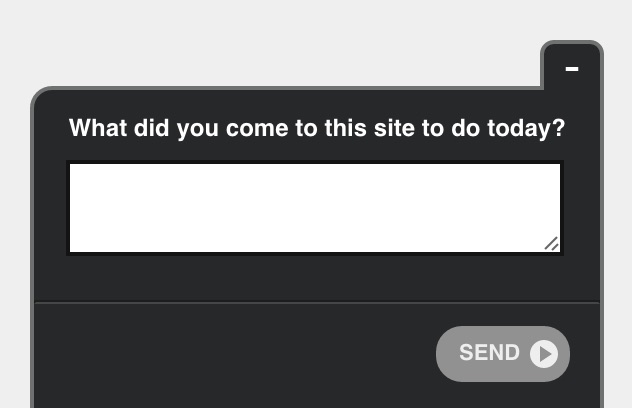
You’ve likely seen them at the bottom of websites, such as our homepage:
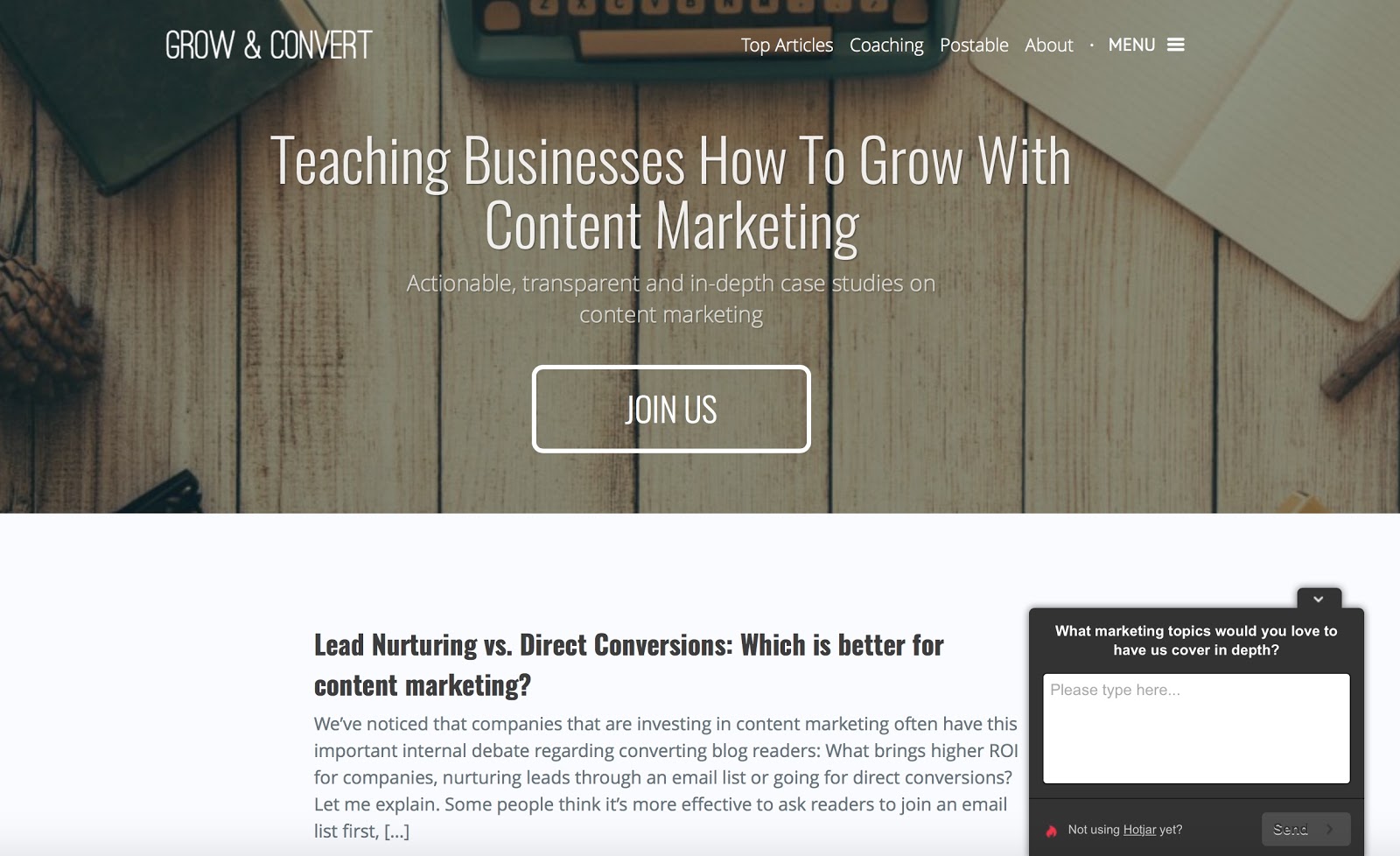
They can be triggered by time on page, scroll amount, or exit intent.
We have zero affiliation with any of the dozens of companies that make this type of survey tool, but we use Hotjar and here are some more options from this Quora question where people discuss the competitors:
Aside: Look at how competitive this space is. Isn’t it amusing that to stand out in the customer survey space, you’ll need to understand the pains, hopes, dreams, and fears of the customers better than everyone else? It’s the opposite of irony. What’s the word for that?
You apply this to your site the same way as most website tools: put their javascript snippet on every page and run everything else from the company’s dashboard.
That’s it. Check out any of the software company’s sites above for more info on how to set them up.
Now let’s talk strategy.
Using Customer Feedback Tools To Improve Sales: Find Out Why Customers Don’t Purchase
One of the biggest objections we hear to email based surveys is along the lines of:
We don’t want to over-email our customers.
Even after a company sends a survey and gets great insights, there’s a hesitation about when they can email again.
No single survey tells you every single thing you need to know about your customers, and often times, the answers you get spark additional questions that you’re dying to ask.
For example, a client of my conversion optimization agency sells swimsuits to women. To understand what content was missing from their product pages, we asked first this:
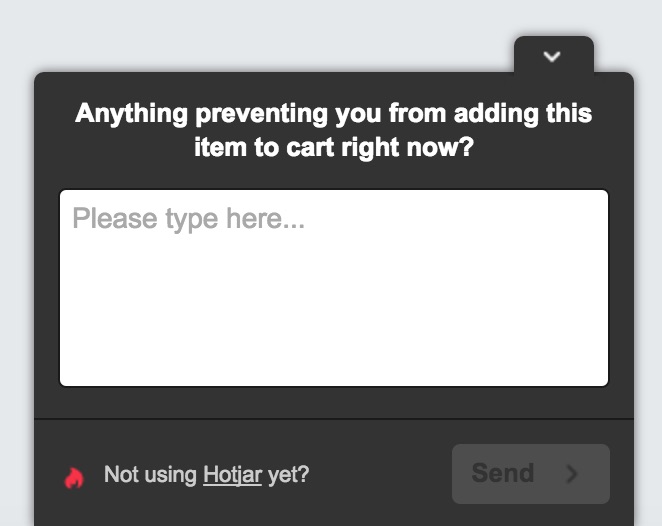
We were looking for responses that could help us build more persuasive product pages.
For example:
- Were they unsure about returns?
- Were they looking for certain features?
- Could they not find the products they were looking for?
- Did they want a discount?
- Etc.
We got some good insights on those fronts, but we also got a sizeable number of unexpected responses like these:
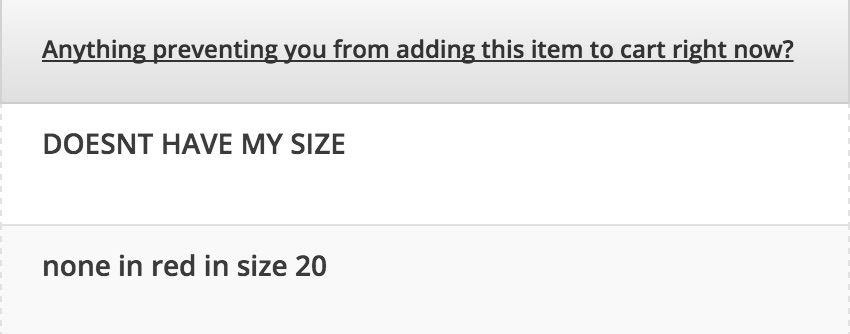
Hold the phone. They don’t have enough sizes? This is a plus size swimsuits site, the right size selection is a core part of the value proposition.
Obviously, that’s not a UI/UX issue, it’s a merchandizing issue. So it’s not something we can “fix” with an AB test, but it’s incredibly insightful.
But now, as a result of this one survey question, we wanted to ask another.
We wanted to know the exact products and sizes potential customers wanted, but that the store didn’t carry. We also wanted to know what percentage of users could find their size versus could not (how big of a problem was this?).
Asking this follow up question is simple with an on-site feedback survey: we just stopped the question above and turned on this two part question instead:
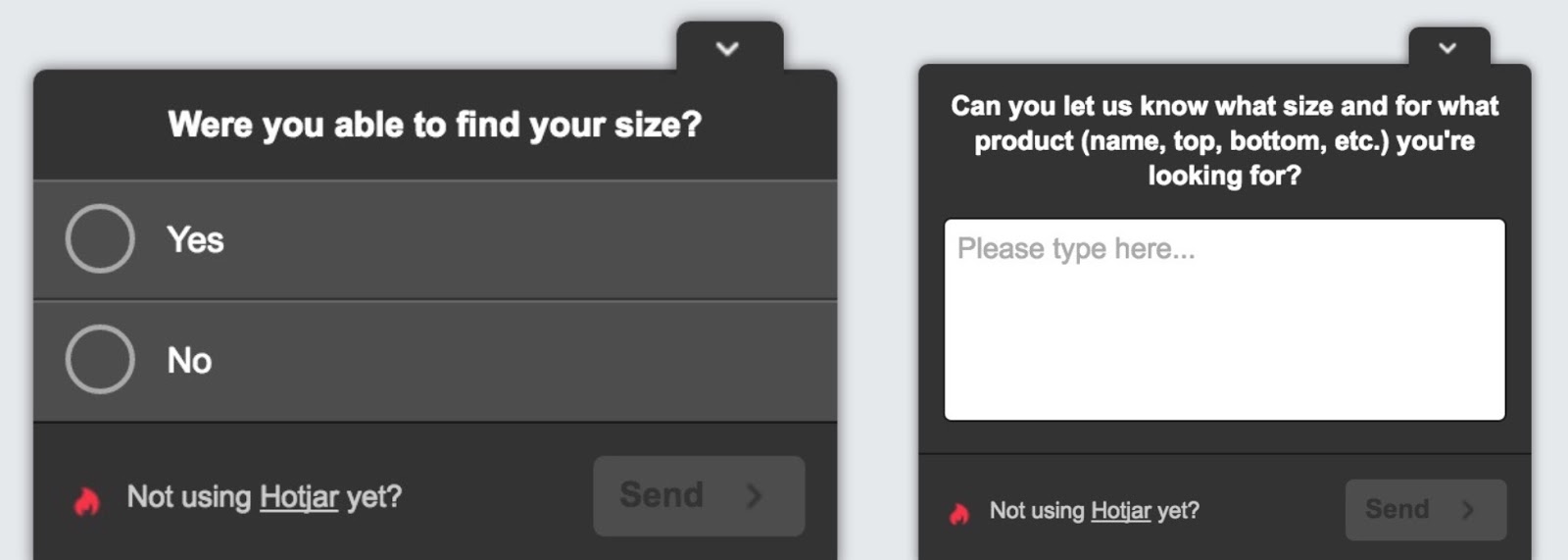
Despite the clunky and grammatically incorrect second question, we got exactly what we were looking for:
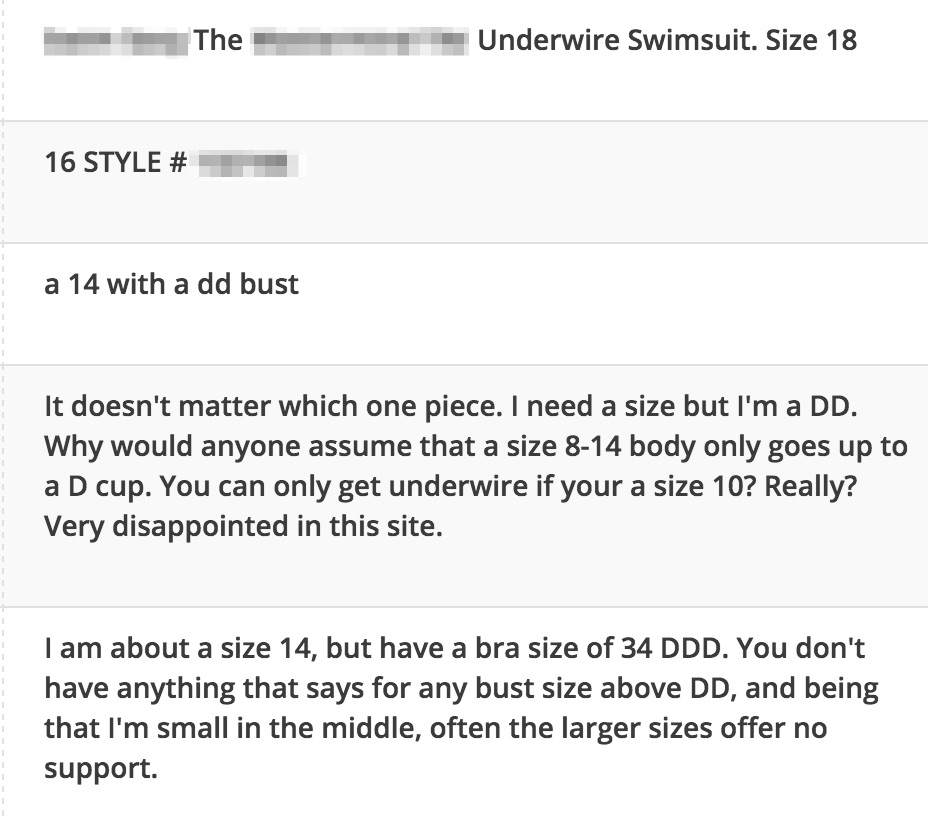
In addition to just “I want this product in this size” feedback, look at the subtleties we got from certain customers and their frustrations. Men may not understand this (I certainly didn’t) but buying a swimsuit as a woman isn’t as simple as finding one size number.
The last two responses in the sample screenshot above will show the product team (not just the marketing team) that there are customers with this frustration: for smaller swimsuits, women weren’t finding a bust size that worked for them.
What’s more, you get a sense from reading this feedback that these prospects want to find a solution that works. They want to buy. They’re just frustrated that the product offering is not quite right for them.
Our hypothesis: The company is losing these otherwise easy sales.
If you’re curious about how this “ended”, these are recent results, so merchandizing decisions to appease these complaints are still in the works.
Grow and Convert Monthly Coaching
We recently started asking a similar question on our coaching page:
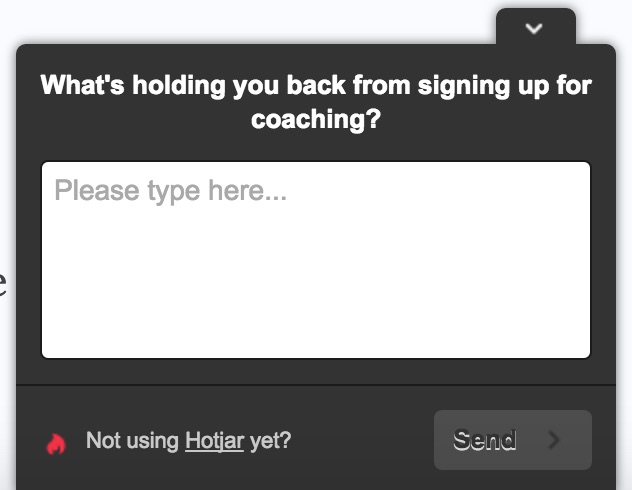
And have a few responses already:
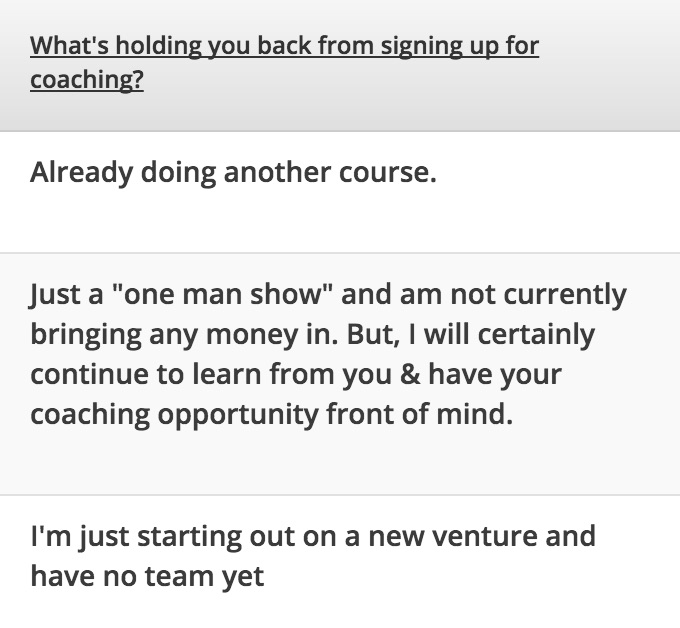
Even though we just have a few responses, we’ve already seen two people mention that they are just starting out, which is an interesting nugget about the type of people that are hitting that page and have some interest in the program.
After a dozen or more responses we should be able to uncover some more insights.
Hidden Content Opportunities
Finally, this benefit is not exclusive to on-site surveys, but is a benefit nonetheless: product frustrations can often be leveraged as content opportunities.
In this case of the plus size swimsuit site, we saw the frustration that many women had about finding unique combinations of top/bottom sizes when buying a swimsuit. A swimsuit sizing guide, an interactive swimsuit sizing “mini app” or something similar could be a great content or mega project opportunity.
Using On-Site Customer Feedback Surveys To Create Copy That Compels Customers To Purchase
Another wonderful page-specific use of on-site polls is getting direct customer quotes for copy on your marketing site. For example:
- How do you figure out what benefits are most interesting to your users?
- What features are making them sign up?
- What headline or sub-headline would resonate the most?
This use case can be really impactful for businesses such as SaaS, services (agencies), marketplaces (Upwork, Codeable, etc.), that generally have this onboarding flow:
- User browses the marketing site, which usually consists of: homepage summary, features, product, services, pricing, case studies, etc.
- If the user is persuaded, they “convert” by signing up for a demo, free trial, free plan, or purchasing the product outright.
These types of businesses are notorious for feature overload. For example, ask a founder of a SaaS company to explain what their company does and in 0.5 seconds you’ll be knee deep in feature minutiae.
But if you’re a marketing manager that wants to optimize the list of features, change messaging, optimize headlines, or focus more on benefits, it can be a fight (with executives, founders, product managers, engineers):
“No way Robbie, we HAVE to mention this feature…”
It’s easy to lecture your coworkers on persuasion best practices like the features vs. benefits principle. But the frustrating paradox is prospective customers of these businesses do want to know what features are available.
For example, the one reason I use Hotjar vs. others for our surveys is because of its features. In addition to on-site surveys, it also includes screen recording, form analytics, and heatmaps at a damn good price, so I don’t have to use 3 or 4 separate tools. (I promise we have no relationship with them, I’m just being honest.)
But what features are the most important to your business? What benefits should be mentioned at the top? How should you word your headline? Would more screenshots work better than more case studies?
These are hard questions to answer.
It often takes many iterations and months (or years) to get it right. That’s okay. We’re not here to oversimplify things and tell you to just follow these “15 best practices” and sales will go through the roof.
But what we are saying is that by asking your customers the right questions, it can help you figure out the right combination of words, features and benefits to make customers purchase.
For example, for a SaaS client that makes a communications app (web, iOS, and Android) for small business owners, we asked this question:
What more do you want to know about [PRODUCT] before signing up?
There were a huge number of users that wanted to know how it worked.
Interesting…we thought we already explained that!
Instead of asking follow up questions (after we asked this first question) and digging deep into their answers, we jumped to conclusions and started testing what we assumed would satisfy them.
We tested putting a bunch of features from the features page right on landing pages. Didn’t work.
Then we tested featuring the how it works video on the page more prominently. Didn’t work.
Doing this was a big mistake. Instead of assuming, we should’ve just asked our customers more questions to figure out what we didn’t explain well.
We went through numerous tests that took up a bunch of time and resources, and all of that could’ve been saved by asking the right questions.
We eventually found out that all customers wanted to know was that the product was easy to use and that we didn’t explicitly say that anywhere on the site.
The customers of this company were small business owners, who are notoriously: busy, stressed out, and in this case, not tech savvy.
They didn’t want to waste time learning something complex. They needed a product that was intuitive and easy to use.
If we had asked the follow up questions needed to get to this conclusion early on, we would’ve found the answer to increasing sales much faster.
After numerous iterations, we finally changed the wording on the site to a simple section that explained how the product works in 3 steps (and got the results we were looking for).
The new copy subtly mentioned features, and wrapped them in benefit-heavy copy. This, along with some other minor changes we made to the page, increased signups 7.6%.
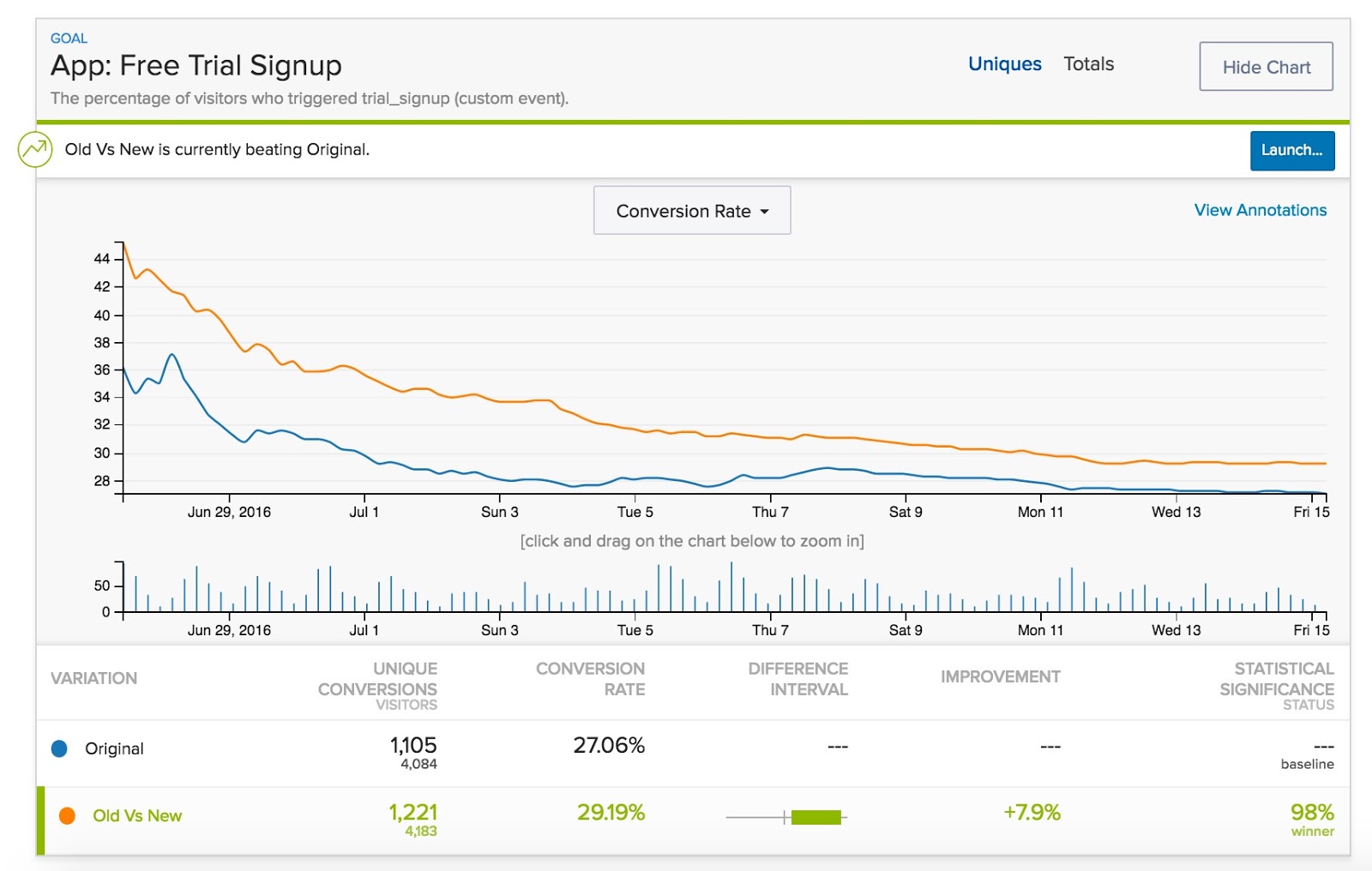
There are a bunch of ways we could have used on site polls to lead us in the right direction before running all of the previous failed tests:
- We could have asked users who just signed up what made them sign up
- We could have asked users inside the app what they like most about it.
- We could have asked an iterative question on the homepage about what one feature or benefit the prospects were hoping to get.
- We could have asked a myriad of questions about prospects’ pain points
I could go on and on…
Hidden Content Opportunities
Just like the e-commerce example above, these types of businesses can also leverage survey answers to create content that attracts their ideal customers.
For example, a todo list app may ask what users biggest frustrations with todo lists are and find a bunch of users complaining about saying yes to too many requests – not the mechanics of their actual to-do list. Not only can this be leveraged for on site copywriting (emphasize more free time, and de-emphasize some nerdy feature), but it can also make for content pieces that attract bottom of the funnel customers that are likely to convert: i.e. how to say no to requests, how to delegate tasks or projects, etc.
A mobile development agency could learn that most prospects have tried to develop the app “themselves” by finding solo contractors for each step of the process: interaction designer, visual designer, coder, etc.
So, the company could create content on ‘how to manage a remote mobile development team’, or ‘how to find the best Swift coders’. This could be a great way to attract middle of funnel customers.
Using Survey Tools to Simply Ask Customers What Resources to Create
I want to mention another simple way of getting continuous feedback on customer pain points and content ideas: ask your readers what else they want to read on your blog.
We recently installed this poll on our homepage:
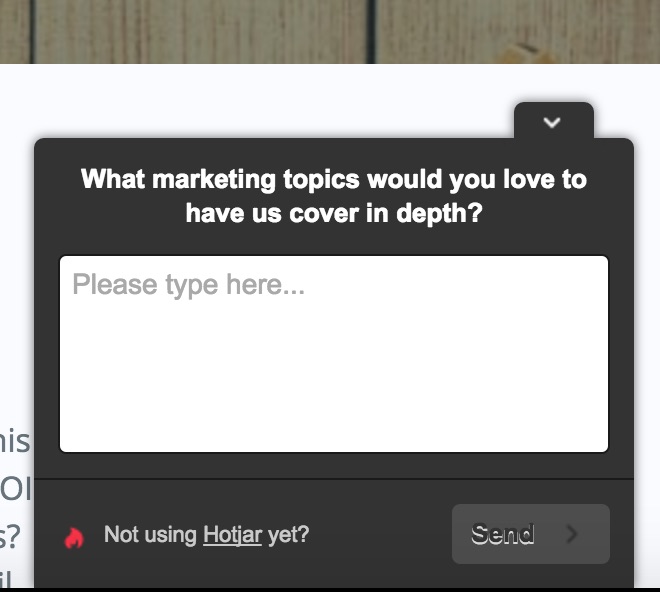
Response rates are low right now, but we’ve begun receiving responses:
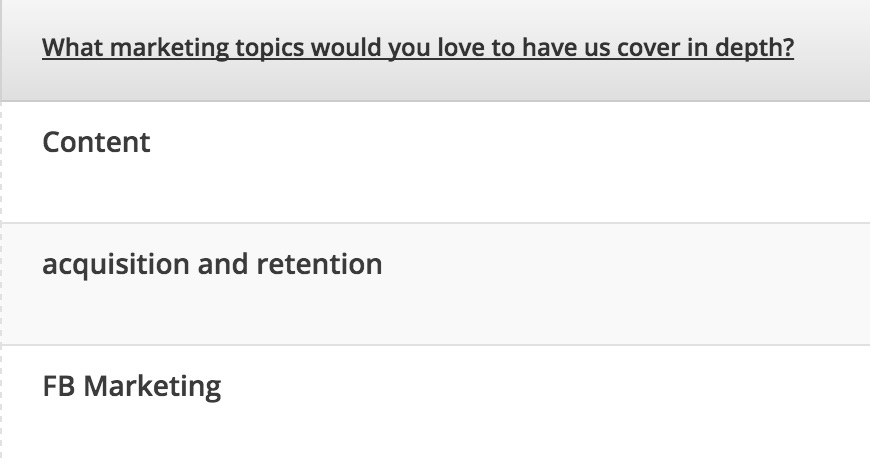
There are other ways that we’re hoping to increase responses. In particular we’re keen on these two ideas:
- We can trigger a question like this when a reader reaches the end of a post (and they are very engaged, as opposed to on our homepage).
- We can ask topic specific questions to get more ideas and insights into readers’ pain points on specific posts, such as hiring writers, conversions, user research, etc.
We’ll be testing these methods soon.
Advantages of using instant, on-site, page specific surveys
Above we covered the tactics of what questions you can ask where for different business types. Now, let’s step back and understand, from a strategy perspective, the advantages of on-site surveys.
Instant responses are more detailed responses
For ecommerce companies with many products (like apparel), it’s very hard to get product specific feedback like the first use case over email. We were asking the size question at the exact moment the customers had the frustration.
Ask them a week later over email? They may not remember exactly what product details were frustrating them. They may have looked at 10 products on your site then another 10 on your competitor’s site. Information can get muddled and you lose the insight.
Stops you from jumping to conclusions
Let’s just put this out there: we marketers are experts at jumping to conclusions.
The last half decade of “growth” and “lean startup” trends help push us towards this:
“Iterate quickly!”
“Fail fast!”
“High throughput growth experiments!”
Look, there is a lot of value in this philosophy, and by and large, I agree with it. But like anything, the devil is in the details.
In this case, not understanding why an idea “failed” is the devil.
And this “why” is very often qualitative, not quantitative. That is, you need your customer to talk about their reasoning, not just look at some analytics numbers yourself.
In the swimsuits example above, a rash decision would be to pull a new product from the store because it wasn’t selling well. But you wouldn’t even know that a simple thing like a few size combinations could be the difference between low selling and high selling.
(To be fair to the lean startup movement, they emphasize this customer feedback step extensively. But most people just don’t do it.)
Your Turn: Prep Your Own On Site Polls
We want to help you take action on this, even if it’s a tiny step. So we’ve prepared this action item. It doesn’t take long and like you saw above, the results can be transformative:
Stop for 5 minutes and brainstorm two things that could pay big dividends for your company’s site-based lead generation.
- First, what are the three most high impact or high traffic pages on your site?
- Second, think of 5 questions for each page that, if you got the answers to, could help validate, invalidate, or totally change assumptions you are making on that page about what your users want.
- Finally, pick one question to start with for each page.
The resulting list is your initial on-site customer feedback survey plan. (Think of how impactful getting all 15 questions answered would be.)
Or, take the very first step right now by mentioning in the comment what the #1 most critical conversion page (or page category) on your site is — this is the page where insights from on site polls would be most useful. Is it your homepage? Product page? Signup page? Pricing page?
Want us to write an in depth case study or story like this about you or your company? We’ll also drive traffic to it. Apply here.
Like this article? We produce stories like these for our clients, learn more here.
On-Site Survey Spreadsheet
Get the spreadsheet
We'll send it by email and add you to our free newsletter, where we send in depth content marketing articles (like this one) as well as exclusive email-only ideas about once a week. It's free and you can unsubscribe at any time.








